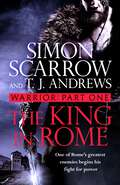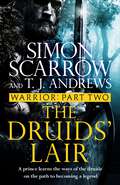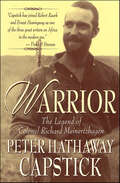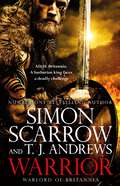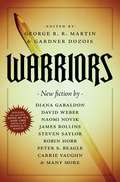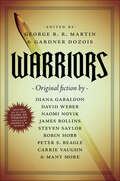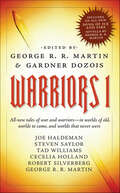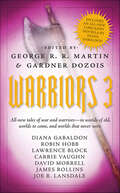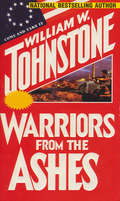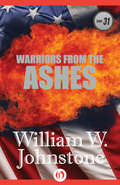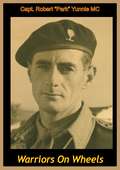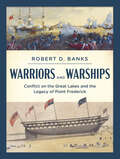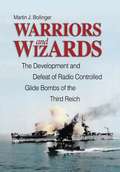- Table View
- List View
Warrior: Part Four of the Roman Caratacus series (Warrior)
by Simon ScarrowWARRIOR: BROTHERS OF THE SWORD is the fourth ebook novella in the WARRIOR series, telling the dramatic story of Caratacus - barbarian enemy of RomeDon't miss DEATH TO THE EMPEROR - the thrilling new Eagles of the Empire adventure featuring Macro and Cato! On sale now.AD 26, Britannia. After leading his men to victory in his first true battle against a neighbouring tribe, Prince Caratacus has come of age. Now, as fears grow of a Roman invasion, he proposes a daring plan: to undermine the enemy through a series of ruthless surprise raids.Caratacus is prepared for a gruelling campaign, in the midst of a harsh winter. But those close to him are troubled by his plan to break the honoured traditional rules of tribal warfare: not only is their honour at stake, but they also fear incurring the wrath of the Druids. As Caratacus and his brothers battle their way forward in dangerous terrain, he faces a threat from within . . .Warrior: the new series set in Britannia - the wildest reach of the Roman Empire . . . From the Sunday Times bestselling authors of Invader and Pirata.
Warrior: Part Four of the Roman Caratacus series (Warrior)
by Simon ScarrowWARRIOR: BROTHERS OF THE SWORD is the fourth ebook novella in the WARRIOR series, telling the dramatic story of Caratacus - barbarian enemy of RomeDon't miss DEATH TO THE EMPEROR - the thrilling new Eagles of the Empire adventure featuring Macro and Cato! On sale now.AD 26, Britannia. After leading his men to victory in his first true battle against a neighbouring tribe, Prince Caratacus has come of age. Now, as fears grow of a Roman invasion, he proposes a daring plan: to undermine the enemy through a series of ruthless surprise raids.Caratacus is prepared for a gruelling campaign, in the midst of a harsh winter. But those close to him are troubled by his plan to break the honoured traditional rules of tribal warfare: not only is their honour at stake, but they also fear incurring the wrath of the Druids. As Caratacus and his brothers battle their way forward in dangerous terrain, he faces a threat from within . . .Warrior: the new series set in Britannia - the wildest reach of the Roman Empire . . . From the Sunday Times bestselling authors of Invader and Pirata.
Warrior: Part One of the Roman Caratacus series (Warrior)
by Simon Scarrow T. J. AndrewsWARRIOR: THE KING IN ROME is the first episode of the story of Caratacus - barbarian enemy of Rome. ALSO COMING SOON (IN NOVEMBER 2022): DEATH TO THE EMPEROR - the thrilling new Eagles of the Empire adventure. Pre-order now!AD 61. Rome. Boudica's rebellion against Roman rule has failed. At a celebratory banquet, an ambitious historian, Caius Placonius Felicitus, takes an interest in a mysterious guest: Caratacus. Once a high king of Britannia, now living in exile, Caratacus gradually opens up to Felicitus. And the young Roman soon realises that Caratacus's is the story he has been waiting all his life to tell.AD 18. Britannia. Caratacus's tale begins as he - quick-witted youngest son of the tribal king Cunobelinus - humiliates his own brother in a war of wits. Cunobelinus decrees that the teenage prince continue his studies under the Druids at a sinister sanctuary, nestled in a remote valley in the lands of the Silures . . . But Caratacus will need all his new skills, as well as his natural cunning, to survive . . .The brand new series from the Sunday Times bestselling authors of Invader and Pirata: Warrior, the story of Britannia's barbarian warlord Caratacus.
Warrior: Part One of the Roman Caratacus series (Warrior)
by Simon Scarrow T. J. AndrewsWARRIOR: THE KING IN ROME is the first episode of the story of Caratacus - barbarian enemy of Rome. ALSO COMING SOON (IN NOVEMBER 2022): DEATH TO THE EMPEROR - the thrilling new Eagles of the Empire adventure. Pre-order now!AD 61. Rome. Boudica's rebellion against Roman rule has failed. At a celebratory banquet, an ambitious historian, Caius Placonius Felicitus, takes an interest in a mysterious guest: Caratacus. Once a high king of Britannia, now living in exile, Caratacus gradually opens up to Felicitus. And the young Roman soon realises that Caratacus's is the story he has been waiting all his life to tell.AD 18. Britannia. Caratacus's tale begins as he - quick-witted youngest son of the tribal king Cunobelinus - humiliates his own brother in a war of wits. Cunobelinus decrees that the teenage prince continue his studies under the Druids at a sinister sanctuary, nestled in a remote valley in the lands of the Silures . . . But Caratacus will need all his new skills, as well as his natural cunning, to survive . . .The brand new series from the Sunday Times bestselling authors of Invader and Pirata: Warrior, the story of Britannia's barbarian warlord Caratacus.
Warrior: Part Three of the Roman Caratacus series (Warrior)
by Simon ScarrowThe stunning third ebook novella in the WARRIOR series, telling the dramatic story of Caratacus, Britannia's barbarian warlord. From the Sunday Times bestselling authors of INVADER and PIRATA.AD 25, Britannia. After nearly eight years training under the Druids, Caratacus - now a powerful young warrior - is abruptly summoned back home to his father's kingdom. The heir to a contested neighbouring land has mysteriously died, and a crisis is brewing. On his arrival, Caratacus finds his father struggling to balance the competing Roman and British influences in his tribe . . . and within his family.When Caratacus's Celtic force discovers corruption and bribery at the heart of the crisis, a bitter fight breaks out. Caratacus and his band escape: but they know that the real battle against external forces has only just begun . . .Warrior: the new series set in Britannia - the wildest reach of the Roman Empire . . . From the Sunday Times bestselling authors of Invader and Pirata.
Warrior: Part Three of the Roman Caratacus series (Warrior)
by Simon ScarrowThe stunning third ebook novella in the WARRIOR series, telling the dramatic story of Caratacus, Britannia's barbarian warlord. From the Sunday Times bestselling authors of INVADER and PIRATA.AD 25, Britannia. After nearly eight years training under the Druids, Caratacus - now a powerful young warrior - is abruptly summoned back home to his father's kingdom. The heir to a contested neighbouring land has mysteriously died, and a crisis is brewing. On his arrival, Caratacus finds his father struggling to balance the competing Roman and British influences in his tribe . . . and within his family.When Caratacus's Celtic force discovers corruption and bribery at the heart of the crisis, a bitter fight breaks out. Caratacus and his band escape: but they know that the real battle against external forces has only just begun . . .Warrior: the new series set in Britannia - the wildest reach of the Roman Empire . . . From the Sunday Times bestselling authors of Invader and Pirata.
Warrior: Part Two of the Roman Caratacus series (Warrior)
by Simon Scarrow T. J. AndrewsWARRIOR: THE DRUIDS' LAIR is the second ebook novella in the WARRIOR series, telling the dramatic story of Caratacus - barbarian enemy of Rome.AD 18, Britannia. Prince Caratacus arrives at the Druid sanctuary in the far west of the island of Britannia, in the mountainous valleys of the Silurians. The prince endures unpleasant initiation rites and proves his mettle in training. What he does not expect to find is an enemy: a bullying fellow scholar, Eboricus.As the young novices endure a brutal regime of combat training and study, Caratacus quicky realises that he is far from Eboricus's only victim. Caratacus knows he must find a way to confront his tormentor - but a contest of strength against the much older Eboricus is surely beyond him. And even his closest allies in this shadowy sanctuary may not be what they seem . . .Warrior: the new series set in Britannia - the wildest reach of the Roman Empire . . . From the Sunday Times bestselling authors of Invader and Pirata.
Warrior: Part Two of the Roman Caratacus series (Warrior)
by Simon Scarrow T. J. AndrewsWARRIOR: THE DRUIDS' LAIR is the second ebook novella in the WARRIOR series, telling the dramatic story of Caratacus - barbarian enemy of Rome.AD 18, Britannia. Prince Caratacus arrives at the Druid sanctuary in the far west of the island of Britannia, in the mountainous valleys of the Silurians. The prince endures unpleasant initiation rites and proves his mettle in training. What he does not expect to find is an enemy: a bullying fellow scholar, Eboricus.As the young novices endure a brutal regime of combat training and study, Caratacus quicky realises that he is far from Eboricus's only victim. Caratacus knows he must find a way to confront his tormentor - but a contest of strength against the much older Eboricus is surely beyond him. And even his closest allies in this shadowy sanctuary may not be what they seem . . .Warrior: the new series set in Britannia - the wildest reach of the Roman Empire . . . From the Sunday Times bestselling authors of Invader and Pirata.
Warrior: The Autobiography of Ariel Sharon
by Ariel SharonThe autobiography of one of the most controversial personages in contemporary Israel with his comments on his life, the military, government workers and politics.
Warrior: The Legend of Colonel Richard Meinertzhagen
by Peter Hathaway CapstickPeter Hathaway Capstick died in 1996. At the time of his death, the world-renowned adventure writer was putting the finishing touches on this, a stirring and vivid biography of Colonel Richard Meinertzhagen, a man with whom he felt he had much in common. Edited and prepared for publication by his widow, Fiona Capstick, Warrior is Capstick’s riveting farewell to his fans and the final addition to the bestselling Peter Capstick Library.Colonel Richard Meinertzhagen was one of those rare men whom fate always seems to cast in the dramas that shape history. As a young officer, he served in India and Africa during the glory days of the British Empire, defending the crown’s dominions and exploring its darkest reaches. His exploits in the bloody colonial wars of turn-of-the-century East Africa earned him a reputation as one of the most fierce and ruthless soldiers in the Empire, yet it was during those years spent roaming the silent places of the Serengeti, hunting its game and learning its secrets, that Meinertzhagen developed a fascination with Africa that would last a lifetime.But there were other adventures to come, and Capstick narrates them all with his trademark skill and wit: daring commando raids against German forces in Africa and the Mideast during World War I, covert missions to the USSR and Nazi Germany between the wars, work as an OSS agent during World War II, and Meinertzhagen’s ceaseless support of Israeli nationhood are all woven together into an epic adventure. Warrior: The Legend of Colonel Richard Meinertzhagen is a powerful chronicle that follows the tracks of a twentieth-century icon.
Warrior: The epic story of Caratacus, warrior Briton and enemy of the Roman Empire…
by Simon ScarrowAD 18, Britannia.The Roman Empire rules much of the known world. Beyond the northern frontier lies Britannia, where ceaseless feuding amongst the Celts leaves the island vulnerable to Rome's ambitions.Caratacus, son of a powerful king, has no premonition of destiny when he is dispatched to train with the Druids. A brutal regime transforms the young prince into a warrior with unparalleled military skills - and the strategic cunning essential to outwit a stronger enemy.Nothing can prepare a man for the vicious reality of war. When Caratacus's father takes a stand against aggressive neighbouring tribes, the combat exercises are over; this is a fight to the death. Only the most ruthless of tactics offer any hope of victory. But Caratacus, and the loyal comrades willing to ride with him into hostile terrain, are ready to do whatever it takes - and endure any hardship - to defeat those set on destroying their kingdom . . .As mayhem and carnage spread across the land, everywhere can be felt the malign influence of Rome. Even if the battle is won, conflict with the Empire lies ahead.The brand new series from the Sunday Times bestselling authors of Invader and Pirata: Warrior, the story of Britannia's barbarian warlord Caratacus.Originally published in 5 ebook novellas
Warrior: The epic story of Caratacus, warrior Briton and enemy of the Roman Empire…
by Simon ScarrowAD 18, Britannia.The Roman Empire rules much of the known world. Beyond the northern frontier lies Britannia, where ceaseless feuding amongst the Celts leaves the island vulnerable to Rome's ambitions.Caratacus, son of a powerful king, has no premonition of destiny when he is dispatched to train with the Druids. A brutal regime transforms the young prince into a warrior with unparalleled military skills - and the strategic cunning essential to outwit a stronger enemy.Nothing can prepare a man for the vicious reality of war. When Caratacus's father takes a stand against aggressive neighbouring tribes, the combat exercises are over; this is a fight to the death. Only the most ruthless of tactics offer any hope of victory. But Caratacus, and the loyal comrades willing to ride with him into hostile terrain, are ready to do whatever it takes - and endure any hardship - to defeat those set on destroying their kingdom . . .As mayhem and carnage spread across the land, everywhere can be felt the malign influence of Rome. Even if the battle is won, conflict with the Empire lies ahead.The brand new series from the Sunday Times bestselling authors of Invader and Pirata: Warrior, the story of Britannia's barbarian warlord Caratacus.Originally published in 5 ebook novellas
Warrior: The epic story of Caratacus, warrior Briton and enemy of the Roman Empire… (Warrior)
by Simon ScarrowFrom the bestselling author of the Eagles of the Empire novels comes the epic story of Caratacus: a barbarian who united tribes to raise an army against mighty Rome . . .The Romans invaded Britannia in AD 43 confident of victory. They swept through a divided and ill-equipped enemy, scattered across tough terrain. But one man was not prepared to surrender. Caratacus - quick-witted youngest son of a a tribal king - had been trained from birth to be a warrior of power and grit. Sent to be schooled by the Druids in his boyhood, his training meant that an already strong and cunning prince returned to his father's kingdom as a war machine . . .With Caratacus driving them forward, the tribes prepare to repulse an enemy anticipating an easy victory. Fighting not only to stay alive but for their very way of life, these men form a mighty force. The battle is on!The brand new series from the Sunday Times bestselling authors of Invader and Pirata: Warrior, the story of Britannia's barbarian warlord Caratacus.(p) 2023 Headline Publishing Group Ltd
Warriors
by Gardner Dozois George R. R. MartinFrom George R. R. Martin's Introduction to Warriors: "People have been telling stories about warriors for as long as they have been telling stories. Since Homer first sang the wrath of Achilles and the ancient Sumerians set down their tales of Gilgamesh, warriors, soldiers, and fighters have fascinated us; they are a part of every culture, every literary tradition, every genre. All Quiet on the Western Front, From Here to Eternity, and The Red Badge of Courage have become part of our literary canon, taught in classrooms all around the country and the world. Our contributors make up an all-star lineup of award-winning and bestselling writers, representing a dozen different publishers and as many genres. We asked each of them for the same thing--a story about a warrior. Some chose to write in the genre they're best known for. Some decided to try something different. You will find warriors of every shape, size, and color in these pages, warriors from every epoch of human history, from yesterday and today and tomorrow, and from worlds that never were. Some of the stories will make you sad, some will make you laugh, and many will keep you on the edge of your seat. Included are a long novella from the world of Song of Ice and Fire by George R. R. Martin, a new tale of Lord John by Diana Gabaldon, and an epic of humanity at bay by David Weber. Also present are original tales by David Ball, Peter S. Beagle, Lawrence Block, Gardner Dozois, Joe Haldeman, Robin Hobb, Cecelia Holland, Joe R. Lansdale, David Morrell, Naomi Novik, James Rollins, Steven Saylor, Robert Silverberg, S. M. Stirling, Carrie Vaughn, Howard Waldrop, and Tad Williams. Many of these writers are bestsellers. All of them are storytellers of the highest quality. Together they make a volume of unforgettable reading."
Warriors (Warriors Anthologies)
by David Weber Diana GabaldonIncludes a Game of Thrones novella and a Lord John tale from Diana Gabaldon! “Entirely successful. There really is something for everybody in it.” —BooklistFrom George R. R. Martin’s Introduction to Warriors:“Our contributors make up an all-star lineup of award-winning and bestselling writers, representing a dozen different publishers and as many genres. We asked each of them for the same thing—a story about a warrior. Some chose to write in the genre they’re best known for. Some decided to try something different. You will find warriors of every shape, size, and color in these pages, warriors from every epoch of human history, from yesterday and today and tomorrow, and from worlds that never were. Some of the stories will make you sad, some will make you laugh, and many will keep you on the edge of your seat.”Included are a long novella from the world of Song of Ice and Fire by George R. R. Martin, a new tale of Lord John by Diana Gabaldon, and an epic of humanity at bay by David Weber. Also present are original tales by David Ball, Peter S. Beagle, Lawrence Block, Gardner Dozois, Joe Haldeman, Robin Hobb, Cecelia Holland, Joe R. Lansdale, David Morrell, Naomi Novik, James Rollins, Steven Saylor, Robert Silverberg, S. M. Stirling, Carrie Vaughn, Howard Waldrop, and Tad Williams.Many of these writers are bestsellers. All of them are storytellers of the highest quality. Together they make a volume of unforgettable reading.“The editors succeed admirably in their mission to break down genre barriers and focus on pure entertainment.” —Publishers Weekly
Warriors 1 (Warriors Anthologies)
by Joe Haldeman Steven SaylorHeroic tales of combatants across genres and centuries from today’s popular authors—includes a new Song of Ice and Fire novella by George R. R. Martin.From George R. R. Martin’s Introduction to Warriors:“Our contributors make up an all-star lineup of award-winning and bestselling writers, representing a dozen different publishers and as many genres. We asked each of them for the same thing—a story about a warrior. Some chose to write in the genre they’re best known for. Some decided to try something different. You will find warriors of every shape, size, and color in these pages, warriors from every epoch of human history, from yesterday and today and tomorrow, and from worlds that never were. Some of the stories will make you sad, some will make you laugh, and many will keep you on the edge of your seat.”The stories in the first volume of this book are:Introduction: Stories of the Spinner Rack, by George R. R. MartinForever Bound, by Joe HaldemanThe Eagle and the Rabbit, by Steven SaylorAnd Ministers of Grace, by Tad WilliamsThe King of Norway, by Cecelia HollandDefenders of the Frontier, by Robert SilverbergThe Mystery Knight, by George R. R. MartinMany of these writers are bestsellers. All of them are storytellers of the highest quality. Together they make a volume of unforgettable reading.
Warriors 3 (Warriors Anthologies)
by Robin Hobb Diana GabaldonA genre-busting collection of stories about soldiers and fighters from today’s most popular authors—including a new Lord John novella by Diana Gabaldon.From George R. R. Martin’s Introduction to Warriors:“Our contributors make up an all-star lineup of award-winning and bestselling writers, representing a dozen different publishers and as many genres. We asked each of them for the same thing—a story about a warrior. Some chose to write in the genre they’re best known for. Some decided to try something different. You will find warriors of every shape, size, and color in these pages, warriors from every epoch of human history, from yesterday and today and tomorrow, and from worlds that never were. Some of the stories will make you sad, some will make you laugh, and many will keep you on the edge of your seat.”The stories in the third volume of this book are:Introduction: Stories of the Spinner Rack, by George R. R. MartinThe Triumph, by Robin HobbSoldierin’, by Joe R. LansdaleClean Slate, by Lawrence BlockThe Girls from Avenger, by Carrie VaughnThe Pit, by James RollinsMy Name is Legion, by David MorrellThe Custom of the Army, by Diana GabaldonMany of these writers are bestsellers. All of them are storytellers of the highest quality. Together they make a volume of unforgettable reading.
Warriors From The Ashes (Ashes #32)
by William W. JohnstoneRebels wage war again a Nazi madman, a Latin American warlord, and a corrupt president in a post-apocalyptic desert—from a USA Today–bestselling author. Under the command of Ben Raines, the Southern United States of America have defeated all comers—and carved out a stronghold in the Southwest desert. But now, two powerful forces are crashing in against the rebels from the north and the south. A cataclysmic war on two fronts has begun... The glorified thugs of the New World Order have seized Mexico City, and Bruno Bottger's mercenary army has joined forces with the Nicaraguan and Honduran troops of former Sandinista Perro Loco. Meanwhile, U.S. President Claire Osterman is attacking by land and air from the North. Now, Ben Raines has no choice but to strike back with everything he's got. In a firestorm of bullets, bombs, and a new generation of horrifying tactical weapons, one small army must stand against two enemies...and the odds are just about even. Thirty-first in the long-running series!
Warriors From the Ashes (Ashes #31)
by William W. JohnstoneUnder the command of Ben Raines, the Southern United States Of America have defeated all comers - and carved out a stronghold in the Southwest desert. But now, two powerful forces are crashing in against the rebels from the North and the South. A cataclysmic war on two fronts has begun... The glorified thugs of the New World Order have seized Mexico City, and Bruno Bottger's mercenary army has joined forces with the Nicaraguan and Honduran troops of former Sandinista Perro Loco. Meanwhile, U.S. President Claire Osterman is attacking by land and air from the North. Now, Ben Raines has no chance but to strike back with everything he's got. In a firestorm of bullets, bombs, and a new generation of horrifying tactical weapons, one small new generation of horrifying tactical weapons, one small army must stand against two enemies...and the odds are just about even.
Warriors On Wheels
by Capt. Robert “Park” Yunnie MCCaptain Robert Park Yunnie MC (1909-1961) was one of the original officers of "Popski's Private Army" (officially No. 1 Demolition Squadron, PPA), a unit of British Special Forces set up on Cairo in October 1942 by Major Vladimir Peniakoff, MC ("Popski"). Capt. Yunnie was Popski's second in command and leader of "B" patrol."This is the true story of a small group of men who enjoyed World War II. The war was not of their seeking, few of them knew anything about war or wanted it, but when it came they volunteered as a matter of course.One by one, led by a love of adventure, they gravitated to a special service unit called 'Popski's Private Army'. I was second-in-command of Popski's Private Army. I was the first recruit. I trained the men and knew them intimately. I fought with them and joked with them. I shared their triumphs, their failures and their fears. I saw some of them die. I loved these men and was honoured by their friendship and their faith.This story should have been written long ago, when the war ended. It was, but in a different form, and never published; now I have found time to rewrite it, just as it happened during the years of the war."-Author's Preface.
Warriors and Citizens: American Views of Our Military
by Jim Mattis Kori N. SchakeA diverse group of contributors offer different perspectives on whether or not the different experiences of our military and the broader society amounts to a "gap"—and if the American public is losing connection to its military. They analyze extensive polling information to identify those gaps between civilian and military attitudes on issues central to the military profession and the professionalism of our military, determine which if any of these gaps are problematic for sustaining the traditionally strong bonds between the American military and its broader public, analyze whether any problematic gaps are amenable to remediation by policy means, and assess potential solutions. The contributors also explore public disengagement and the effect of high levels of public support for the military combined with very low levels of trust in elected political leaders—both recurring themes in their research. And they reflect on whether American society is becoming so divorced from the requirements for success on the battlefield that not only will we fail to comprehend our military, but we also will be unwilling to endure a military so constituted to protect us. Contributors: Rosa Brooks, Matthew Colford,Thomas Donnelly, Peter Feaver, Jim Golby, Jim Hake, Tod Lindberg, Mackubin Thomas Owens, Cody Poplin, Nadia Schadlow, A. J. Sugarman, Lindsay Cohn Warrior, Benjamin Wittes
Warriors and Politicians: US Civil-Military Relations under Stress (Cass Military Studies)
by Charles A. StevensonWith historical case studies ranging from the Revolutionary War to the war in Iraq, this new book shows how and why the US military is caught between two civilian masters – the President and Congress – in responding to the challenges of warfighting, rearmament, and transformation. Charles Stevenson skilfully shows how, although the United States has never faced the danger of a military coup, the relations between civilian leaders and the military have not always been easy. Presidents have contended with military leaders who were reluctant to carry out their orders. Generals and Admirals have appealed to Congress for sympathy and support. Congressional leaders have tried to impose their own visions and strategies on the US armed forces. This triangular struggle has recurred time and again, in wartime and in efforts to reshape the military for future wars. Illustrating this dual system of civilian military control in a series of case studies, this new volume starts from the way the Continental Congress ran the Revolutionary War by committee and concludes with the George W. Bush and Donald Rumsfeld efforts to transform the US military into a modern terrorist-fighting force. This detailed coverage shows how warriors and politicians interacted at key points in US history. This book will be of great interest to all students of the US Military, government of the United States and of strategic and military studies in general.
Warriors and Warships: Conflict on the Great Lakes and the Legacy of Point Frederick
by Robert D. BanksThe untold story of Point Frederick, where early nineteenth-century Canadians built warships that stopped invasion and brought peace.Warriors and Warships brings to life a much neglected part of Canada’s military history, covering the warships and the people who built them at Point Frederick from the late eighteenth century to the mid-nineteenth century. Opposite Kingston, Point Frederick was the 1789 dockyard home of the Provincial Marine on Lake Ontario and the headquarters of Britain’s Royal Navy from 1813 to 1853. Today, it is the home of the Royal Military College of Canada. In this detailed narrative, with over one hundred colour archival maps, aerial views, photographs, and 3D reconstructions, Banks recounts Point Frederick’s building of great sail and steam warships and the roles these vessels played in conflict on Lake Ontario, the St. Lawrence River, and Niagara. Among the conflicts is the War of 1812, when French Canadian and British shipwrights made warships that forced the U.S. Navy into port and led to the American withdrawal from Canada. Banks also covers the role of the ships in the settlement of Upper Canada, the rebellion of 1837, the early planning of the Rideau Canal, and the beginning of the undefended border. Along the way, Banks introduces an array of people from Upper Canada, such as Lieutenant Governor John Graves Simcoe and his wife, Elizabeth Posthuma; Governor General Lord Dorchester; General Isaac Brock; Sir James Yeo, and even Charles Dickens. He also describes the day-to-day activities at Point Frederick, beyond shipbuilding and military campaigns, such as skating parties, sleigh rides, theatricals, disease and death, and crime and punishment. Banks shares the moments of hardship, triumph, and tragedy of both the warriors and the warships in this important contribution to Canadian history.
Warriors and Wizards
by Martin J. BollingerIn August 1943 the Luftwaffe began using radio-controlled anti-ship glide bombs, and within weeks they had sunk one battleship, crippled another, wrecked two cruisers, and destroyed numerous merchant ships. Yet a year later the Germans abandoned their use, defeated in part by electronic systems to jam the radio links that guided the bombs. Drawing on a wealth of new sources, Martin Bollinger examines what happened from both a historical and technological perspective and lays out a mission-by-mission analysis of effectiveness. Based on interviews with participants, intelligence documents, and archival records in four countries, his book chronicles the yearlong battle between Allied seamen and Luftwaffe airmen (the warriors) and German and Allied scientists (the wizards) for a story of courage, technical achievement, and sacrifice.
Warriors at the Little Bighorn 1876
by Richard HookThe battle which took place on the Little Bighorn river on June 25, 1876 has passed into legend as "Custer's Last Stand". This remarkable book is a unique analysis of the oral and pictorial evidence for the appearance of nearly 30 named Sioux and Cheyenne warriors who were present that day, and for their parts in the battle. The fruit of many years' study by one of today's most internationally respected interpreters and illustrators of Native American material culture, it offers biographical notes and meticulously researched color reconstructions, together with rare photographs and pictographs.

